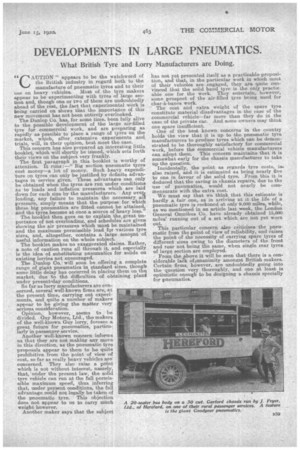DEVELOPMENTS IN LARGE PNEUMATICS.
Page 19

If you've noticed an error in this article please click here to report it so we can fix it.
What British Tyre and Lorry Manufacturers are Doing.
66 AUTION " appears to be the watchword of
the British industry in regard both to the manufacture of pneumatic tyres and to their use on heavy vehicles. Most of the tyre makers appear to be experimenting with tyres of large section and, though one or two of them are undoubtedly ahead of the rest, the fact that experimental work is being carried on shows that the importance of this new movement has not been entirely overlooked.
The Dunlop Co. has, for some time, been fully alive to the possible • development of the large air-filled tyre for commercial work, and are preparing as rapidly as possible to place a range of tyres on the market, which, after extensive experiments and _ trials, will, in their opinion, best meet the ease. This concern has also prepared an interesting little booklet, which will shortly be issued, which sets forth their views on the subject very frankly.
The first paragraph in this booklet is worthy of attention. It runs :—" Big section pneumatic tyres cost money—a lot of money. Such heavy expenditure on tyres can only be justified by definite advantages in service given. These advantages can only be obtained when the tyres are rim under conditions as to loads and inflation pressures which are laid down for each size by the manufacturers. Any (were loading, any failure to maintain the necessary alI pressure, simply means that the purpose for which these big pneumatics are fitted cannot be attained, and the tyres become at once a source of heavy loss."
The booklet then goes on to explain the, great importance of not overloading, and schedules are given showing the air pressures which must be maintained and the maximum permissible load for various tyre sizes and, altogether, contains a large amount of useful information on the whole subject. .
The booklet makes no exaggerated claims. Rather, a note of caution runs all through it, and especially is the idea of substituting pneumatics for solids on existing lorries not encouraged.
The Dunlop Co. will soon be offering a complete range of giant pneumatics in standard sizes, though some little delay has occurred in placing them on the market, due to the difficulties of obtaining plant under present-day conditions.
So far as lorry manufacturers are concerned, several well-known firms are, at the present time, carrying out experiments, and quite a number of makers appear to be giving the matter very serious consideration.
Opinion, however, seems to be divided. Guy Motors, Ltd., the makers of the well-known Guy lorry, foresee a great future for pneumatics, particularly in passenger service. Another well-known concern informs us that they are not making any move in this direction, as the pneumatic tyre proposals appear to them to be quite prohibitive from the point of view of cost, so far as really heavy vehicles are concerned. They also raise a point which is not without interest, namely, that, under the present law, the solid tyre vehicle can run at the full permissible maximum speed, thus inferring that, under present conditions, the full advantage could not legally be taken of the pneumatic tyre. ' This objection does not appear to us to carry much weight however. . Another maker says that. the subject has not yet presented itself as a practicable proposition, and that, in the particular work in which most of their vehicles are engaged, they are quite convinced that the solid band tyre is the only practicable one for the work. They entertain, however, some prospect of the air-filled tyre being used for char-a-banes work.
The cost and extra weight of the spare tyre constitute material disadvantages in the case of the commercial vehicle—far more than they do in the case of the private car. And some owners may think one spare insufficient.
One of thebest known concerns in the country holds the view that it is up to the pneumatic tyre manufacturers to produce tyres which can be demonstrated to be thoroughly satisfactory for commercial work, before the commercial vehicle manufacturers can adopt them. This concern maintains that it is somewhat earl/ for the chassis manufacturer to take up the question.
Incidentally, the point as regards tyre costs, isa also raised, and it is estimated as being nearly five to one in favour of the solid tyre. From this it is deduced that the saving in chassis repairs, due to the use of pneumatics, would not nearly be commensurate with the extra cost.
We must say that we think that this estimate is hardly a lair one, as in arriving at it the life of a pneumatic tyre is reckoned at only 9,000 miles, while, as we mentioned in an article last week, the London General Omnibus Co. have already obtained 15,000 miles' running out of a set which are not yet worn out.
This particular concern also criticises the pneumatic from the point of view of reliability, and raises the point of the necessity of carrying spare tyres of different sizes owing to the diameters of the front and rear not being the same, when single rear tyres of large section are employed.
From the above it will be seen that there is a considerable lack of ;unanimity amongst British makers. Certain firms, however, are undoubtedly going into the question very thoroughly, and one at least is optimistic enough to be designing a chassis specially for pneumatics.




























